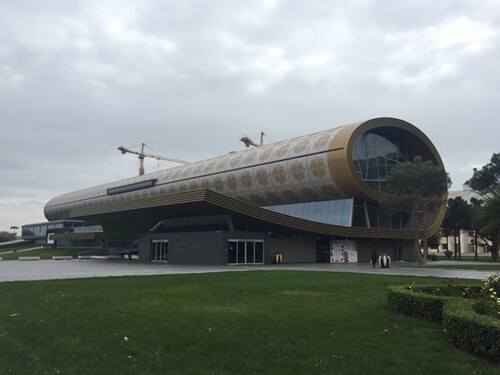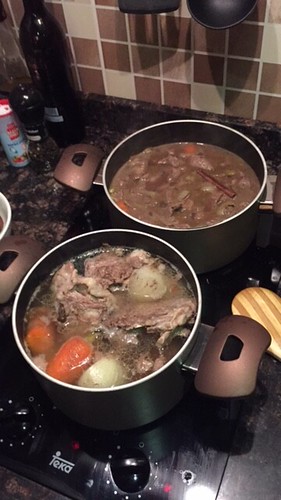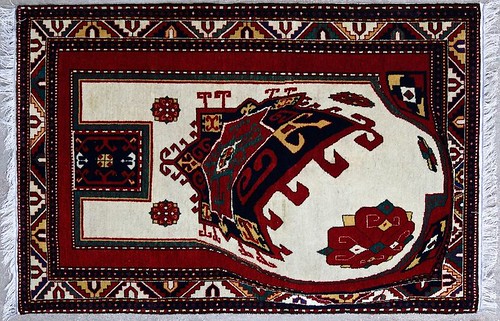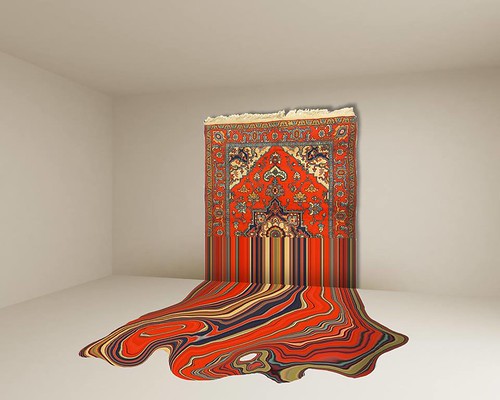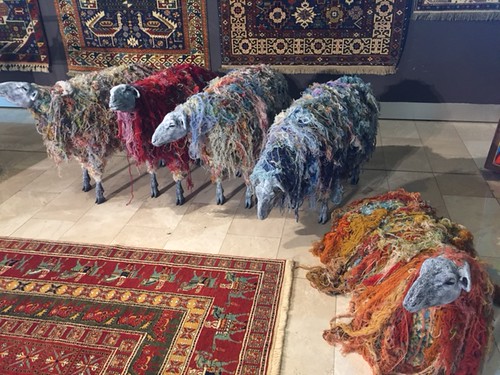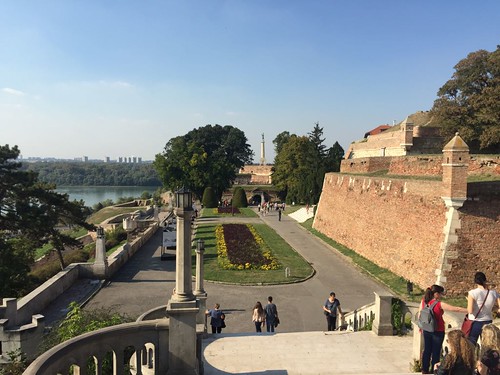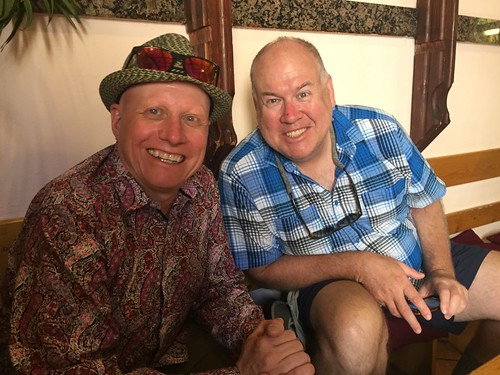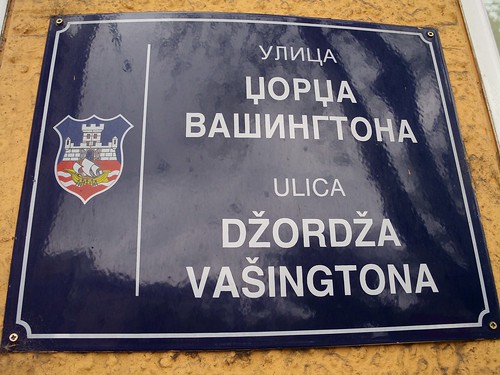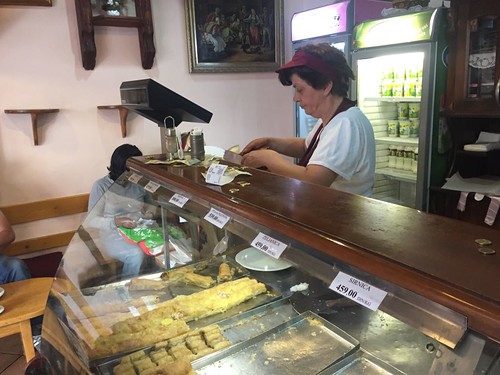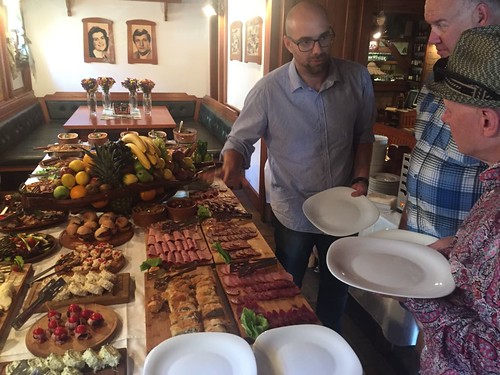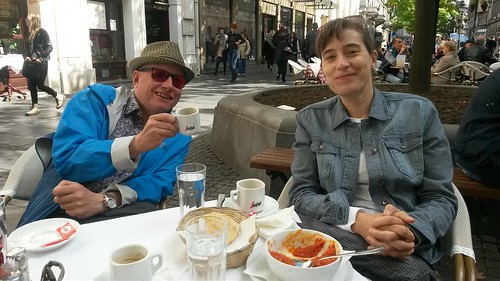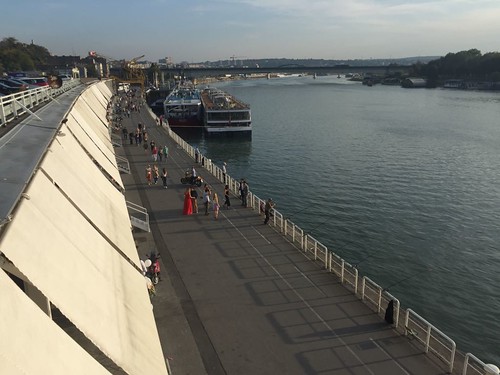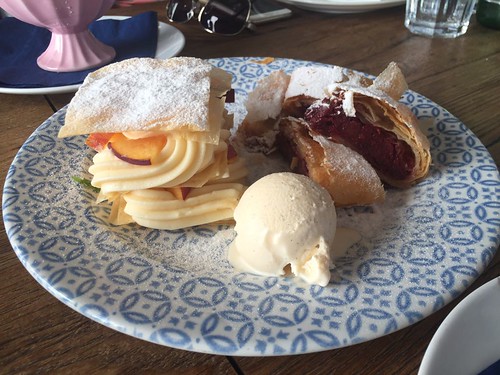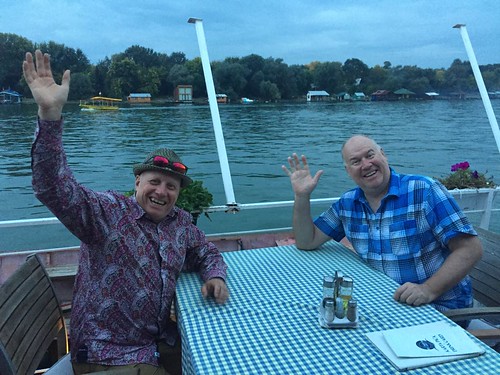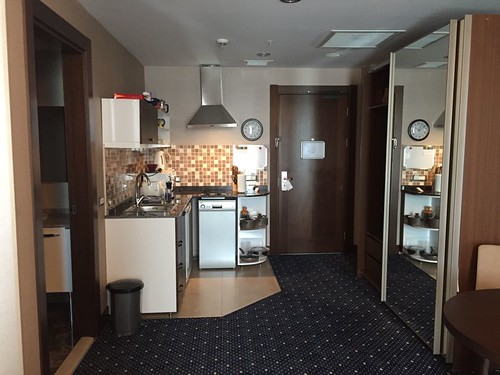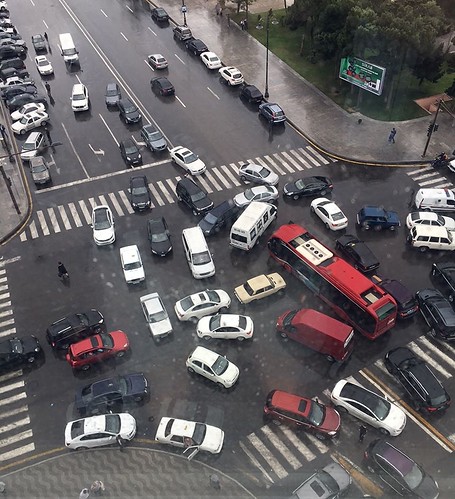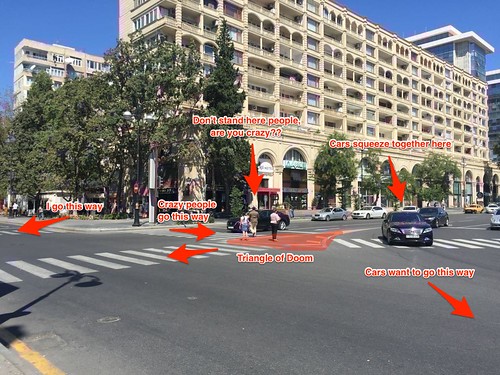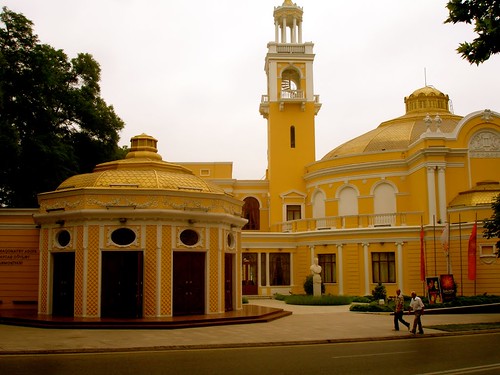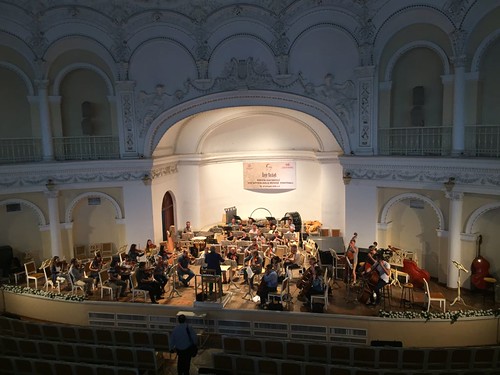In Azerbaijan, carpets are what is technically known as "A Big Deal". Classed by UNESCO as "Intangible Cultural Heritage" carpets have been woven here for centuries. Therefore it's no surprise that there's a dedicated carpet museum in a prominent spot on Baku's Caspian seaside walkway. I didn't make it to the carpet museum during my first tenure in Baku, so lacking any more compelling blog topic to beguile you with I took some time on a quiet Sunday to visit the museum and report back.
The Azerbaijan Carpet Museum started life in 1967 and was first housed in a former mosque in the Old City. It then moved to a downtown building in 1992 after the collapse of the Soviet Union. Interestingly, that building was originally the site of the Lenin Museum, which makes me kind of proud of the Azeris for booting him out and re-asserting their own cultural heritage. Now, though, the museum is finally in a purpose-designed building that is particularly fun because it looks like a carpet!
It's a thoroughly modern museum, complete with 10 AZN admission price, though that included the audio guide. Sadly, the translation and narration of the guide was decidedly mediocre. For the most part it was so garbled and heavily accented that the effort of interpreting the audioguide was far greater than the resulting payback in interesting bloggable facts, so I mostly abandoned it and simply read the posted information accompanying the exhibits, which is all presented in both Azeri and English.
However, one quote from the audioguide had a certain poetry to it, and sums up the importance of carpets to Azeri culture and life:
It was interesting to read the small displays about the process of weaving the carpets, though since weaving is a kind of universal human skill, it was all pretty familiar. Sheep are sheared. The resulting wool is carded and then spun into yarn. The yarn is dyed. And then it's all strung up on a loom. It seems to be mostly the same everywhere, though I did like the story about how, before shearing the sheep, they'd drive the flock back and forth across a river to clean them. Sheep Laundromat!
(It was actually a sheep-ish kind of weekend overall. Back in September during Eid al-Adha I was given a gift of some sacrifical meat. Of course. I mean, who among us hasn't been given two kilos of random cuts of ritually slaughtered sheep by a work colleague? If I had a nickel for every time... Not being overly well-equipped with mutton recipes, I stuffed it in the freezer until the weather turned cool. On the Saturday of Sheep Week I finally thawed it out and spent a lot of time trimming the two kilos into 750 grams of meat and 1250 grams of bones and stuff. The meat turned into a very tasty stew and the trimmings made a small amount of surprisingly rich stock. Check me out - making stock from scratch!
But back to the Carpet Museum. Naturally, there are about eleven zillion carpets displayed, along with other woven household items like bags and curtains and horse blankets and such. It all had a tendency to be a bit same-y, especially the second floor, which was devoted to the imperceptible regional variations in design and production in the different carpet producing areas of Azerbaijan. I say "imperceptible" but of course they were only imperceptible to the untrained eye. I'm sure the preponderance of the buta figure in one areas vs. the use of rhombuses is another is blindingly obvious to some. I am not among them.
Much more compelling was the fact that dotted around the three floors of the museum were five or six working looms with women sitting at each, weaving carpets on the spot. This was absolutely excellent.
Unlike the carpets I saw woven in India where each thread is simply looped through the warp yarns and could actually be pulled out even after the carpet was finished, in Azerbaijan the threads are actually knotted in place. (Which really makes much more sense.) They use a tool that looks like a combination between a crochet hook and a straight razor. A long piece of the right colour of yarn is knotted around the warp thread in the right place with the hooked end of the tool and then trimmed with the razor bit. This all happens at an astonishing pace. Then, every few rows, the woman would stop and trim the knotted yarns so the finished carpet emerged. Again, this is different than in India, where the carpets are trimmed all at once after they're woven by people with very long scissors.
Also along the way, the weavers in the museum used a sort of toothed basher tool to push the knotted threads down into the already woven bits to keep the pile of the carpet dense and even. This quick thump-thump-thump noise of them whacking at the knotted yarn echoed around the otherwise funereally quiet museum in a very pleasing way that brought a bit of life to the place. And while the women that weekend were all making pile carpets on their looms, there were a lot of flat-woven kilim style carpets on display as well. (And in what felt like an oddly coincidental twist, there was a display of kilim from Serbia being shown in a ground floor exhibition space. Sadly, they did not also have an accompanying buffet table groaning with meat and kajmak, which was disorienting and made me wonder if those carpet were REALLY from Serbia at all.)
The top floor of the museum ends with the story of modern carpet making in Azerbaijan. In the 20th century there was a movement to codify a lot of the traditional designs by transferring them to graph paper so they could be recreated accurately in large modern workshops. My notes from the museum say they also established a school of excellence but extensive googling has not revealed any further details. In any case, the upper floor did devote a lot of space to the most famous carpet weaver and designer of that period Letif Karimov, after whom the museum is named.
Notably and disappointingly absent from the museum is any mention of Faig Ahmed, who must surely be the most exciting and modern carpet designer working in Azerbaijan today. It’s tragic and inexplicable that his work is not displayed at the museum because it is totally, mind-bendingly awesome. Here are a few pictures to illustrate, and bear in mind these are NOT photoshopped images. These are photos of actual, physical woven carpets.
The Azerbaijan Carpet Museum started life in 1967 and was first housed in a former mosque in the Old City. It then moved to a downtown building in 1992 after the collapse of the Soviet Union. Interestingly, that building was originally the site of the Lenin Museum, which makes me kind of proud of the Azeris for booting him out and re-asserting their own cultural heritage. Now, though, the museum is finally in a purpose-designed building that is particularly fun because it looks like a carpet!
This is a very new building - opened in 2014, and designed by Austrian Architect Franz Janz.
However, one quote from the audioguide had a certain poetry to it, and sums up the importance of carpets to Azeri culture and life:
"Where is my carpet, there is my home."
Predicatbly, there are a lot of carpets in the carpet museum. They're mostly displayed on the inside of the curved walls that make up the building's skin.
There are still carpet weaving workshops in Baku that spin and dye wool, seen here drying in the sun in the back streets of Baku's fast-disappearing Sovietsky district.
The stew on the back burner and the stock on the front. That stock ended up as about half a cup once it was strained and reduced. But what a half-cup it is! It's now in the freezer awaiting a suitable moment to shine.
Much more compelling was the fact that dotted around the three floors of the museum were five or six working looms with women sitting at each, weaving carpets on the spot. This was absolutely excellent.
This woman was working at a hugely impressive pace.
Also along the way, the weavers in the museum used a sort of toothed basher tool to push the knotted threads down into the already woven bits to keep the pile of the carpet dense and even. This quick thump-thump-thump noise of them whacking at the knotted yarn echoed around the otherwise funereally quiet museum in a very pleasing way that brought a bit of life to the place. And while the women that weekend were all making pile carpets on their looms, there were a lot of flat-woven kilim style carpets on display as well. (And in what felt like an oddly coincidental twist, there was a display of kilim from Serbia being shown in a ground floor exhibition space. Sadly, they did not also have an accompanying buffet table groaning with meat and kajmak, which was disorienting and made me wonder if those carpet were REALLY from Serbia at all.)
The top floor of the museum ends with the story of modern carpet making in Azerbaijan. In the 20th century there was a movement to codify a lot of the traditional designs by transferring them to graph paper so they could be recreated accurately in large modern workshops. My notes from the museum say they also established a school of excellence but extensive googling has not revealed any further details. In any case, the upper floor did devote a lot of space to the most famous carpet weaver and designer of that period Letif Karimov, after whom the museum is named.
I liked a lot of the more modern designs, including this one by a guy whose name I did not record. Sorry, modern carpet guy.
So, so, so cool.
Are you kidding me?
Like I said - awesome. Check out the whole catalogue on his website. And then write a letter to the Azerbaijan Carpet Museum and tell them to smarten up and buy a few original Faig Ahmeds because it's just criminal that he's not represented.
Of course there's a small gift shop in the museum, but I didn't pay much attention there because I've already got a couple very tiny carpets from my last trip. Plus it turns out that boat life and handmade carpets don't really go together so well because those little carpets turned a sad shade of grey dishearteningly quickly when subjected to the normal wear and tear of foot traffic on the boat. Too bad there was no display in the museum on how to clean towpath mud out of your carpet.
And finally, I was pleased to see that the gift shop was also celebrating Sheep Week with a little display that showed that even though they're not hip enough to have any melting Faig Ahmed carpets, they do still have a bit of a sense of humour.
Of course there's a small gift shop in the museum, but I didn't pay much attention there because I've already got a couple very tiny carpets from my last trip. Plus it turns out that boat life and handmade carpets don't really go together so well because those little carpets turned a sad shade of grey dishearteningly quickly when subjected to the normal wear and tear of foot traffic on the boat. Too bad there was no display in the museum on how to clean towpath mud out of your carpet.
And finally, I was pleased to see that the gift shop was also celebrating Sheep Week with a little display that showed that even though they're not hip enough to have any melting Faig Ahmed carpets, they do still have a bit of a sense of humour.

